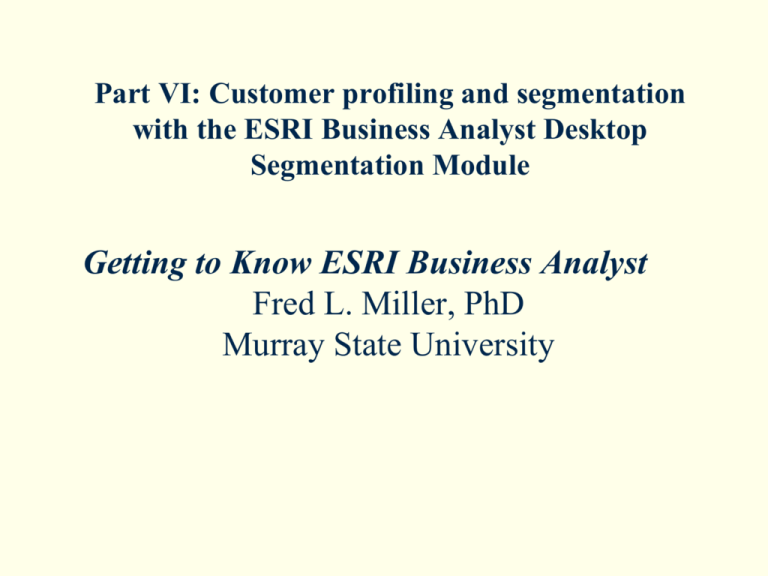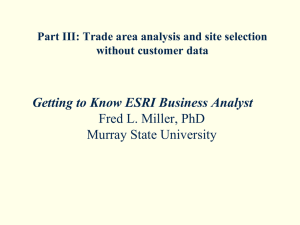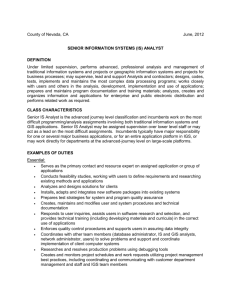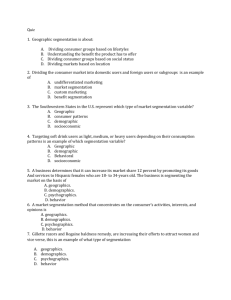Part VI: Customer profiling and segmentation with the
advertisement

Part VI: Customer profiling and segmentation with the ESRI Business Analyst Desktop Segmentation Module Getting to Know ESRI Business Analyst Fred L. Miller, PhD Murray State University Presentation topics This presentation will cover: The decision scenario for Living in the Green Lane Relevant business GIS tools and tasks Chapter 9: Creating customer profiles Geocode customer addresses and attach demographic and segment data to them Develop profiles from customer lists, layers, geographic areas, and survey data Develop reports which summarize customer profile characteristics Assign customers to target groups based on sales history Presentation topics (cont.) Chapter 10: Segmentation analysis for enterprise expansion Assign segments to Core, Developmental, and Niche target groups based on their composition and/or sales volume Create reports using Market Potential Indexes to determine target group behaviors, values, lifestyles, purchasing patterns, and media exposure Assess the potential sales volume of geographic areas based on their similarity with attractive customer profiles Assess the ability of attractive geographic areas to support new company-owned and/or franchised stores Create customized formal Segmentation Studies to support research conclusions and recommendations Evaluation of ROI for business GIS analysis Business GIS learning goals and skills LITGL decision scenario With their expansion plans in the Twin Cities area now complete and their green lifestyle center concept in place, Janice and Steven wish to: Create comprehensive profiles of current customers and their purchasing patterns Identify high-value customers within the existing customer base and establish target groups Use target group profiles to increase sales by penetrating current markets more thoroughly identifying favorable expansion opportunities in other parts of the United States Produce a formal Segmentation Study to document and support these growth plans Relevant business GIS tools and tasks Mapping customer location with geocoding Attaching sales, demographic, and lifestyle data to customer records Generating profiles of high-value customers Identifying local concentrations of high-value customers who are not yet served Identifying potential markets across the country that match the high-value customer profile Estimating the sales potential of potential markets and identify specific attractive store locations within them Preparing comprehensive segmentation studies to support business decision making Chapter 9: Creating customer profiles In this chapter, you will perform the following Business Analyst Desktop tasks: Geocode customer addresses and attach demographic and segment data to them Develop profiles from customer lists, layers, geographic areas, and survey data Develop reports which summarize customer profile characteristics Assign customers to target groups based on sales history Geocode and profile customers with Address Coder Create map, reports, and charts of customer profile data Assign customers to target groups based on sales history Chapter 10: Segmentation analysis for enterprise expansion In this chapter, you will perform the following Business Analyst Desktop tasks: Assign segments to Core, Developmental, and Niche target groups based on their composition and/or sales volume Create reports using Market Potential Indexes to determine target group behaviors, values, lifestyles, purchasing patterns, and media exposure Assess the potential sales volume of geographic areas based on their similarity with attractive customer profiles Assess the ability of attractive geographic areas to support new companyowned and/or franchised stores Create customized formal Segmentation Studies to support research conclusions and recommendations Assign Core, Development and Niche Segments and Generate Market Area and Gap Analysis Map and Report Assess alternative markets for expansion and evaluate opportunities for company-owned and franchised Stores Create comprehensive segmentation study to support plans for sales growth Business GIS learning goals and skills In Part VI you will learn to use Business Analyst Desktop to: Geocode customer addresses and attach demographic and segment data to them Develop profiles from customer lists, layers, geographic areas, and survey data Develop reports which summarize customer profile characteristics Assign customers to target groups based on sales history Assign segments to Core, Developmental and Niche target groups based on their composition and/or sales volume Create reports using Market Potential Indexes to determine target group behaviors, values, lifestyles, purchasing patterns, and media exposure Assess the potential sales volume of geographic areas based on their similarity with attractive customer profiles Assess the ability of attractive geographic areas to support new company-owned and/or franchised stores Create customized formal Segmentation Studies to support research conclusions and recommendations Evaluation of ROI for business GIS analysis The costs of this Business Analyst application are: A Business Analyst Desktop and Segmentation Module The time of managers and business GIS analyst The benefits of this Business Analyst application are: Increased revenue from higher sales at existing stores Optimized projected sales from stores in new geographic areas The estimated incremental revenues are: About $190,000 in increased purchases in existing stores About $6 million difference in projected revenue between selected region and alternatives Part VI: Customer profiling and segmentation with the ESRI Business Analyst Desktop Segmentation Module Getting to Know ESRI Business Analyst Fred L. Miller, PhD Murray State University







